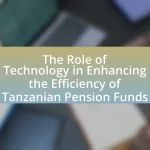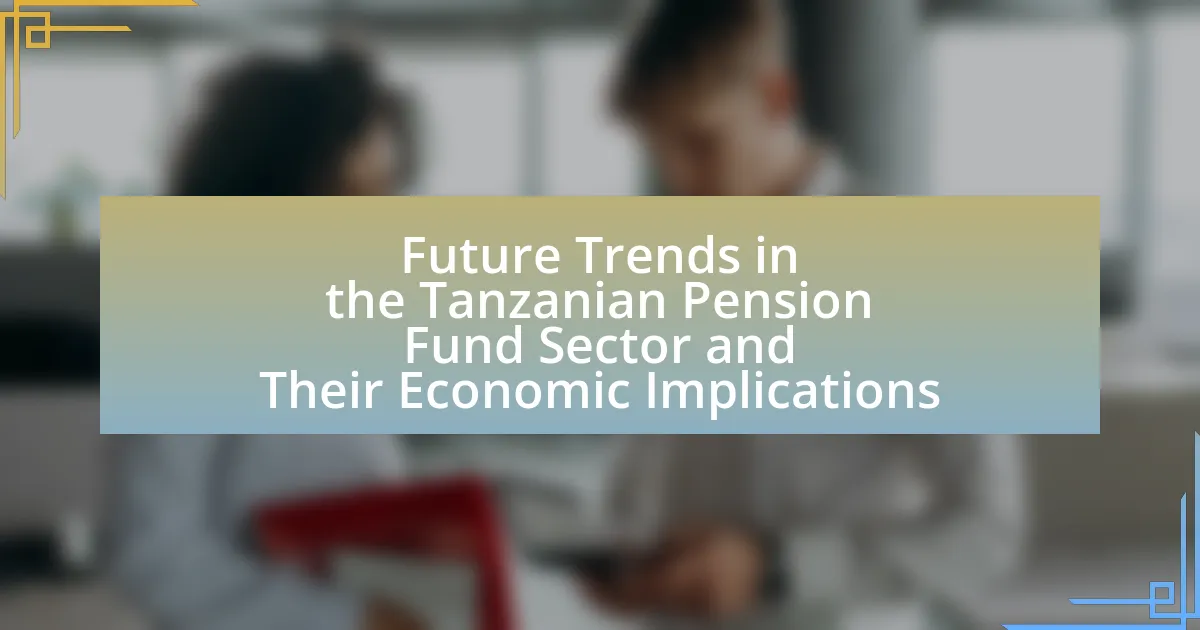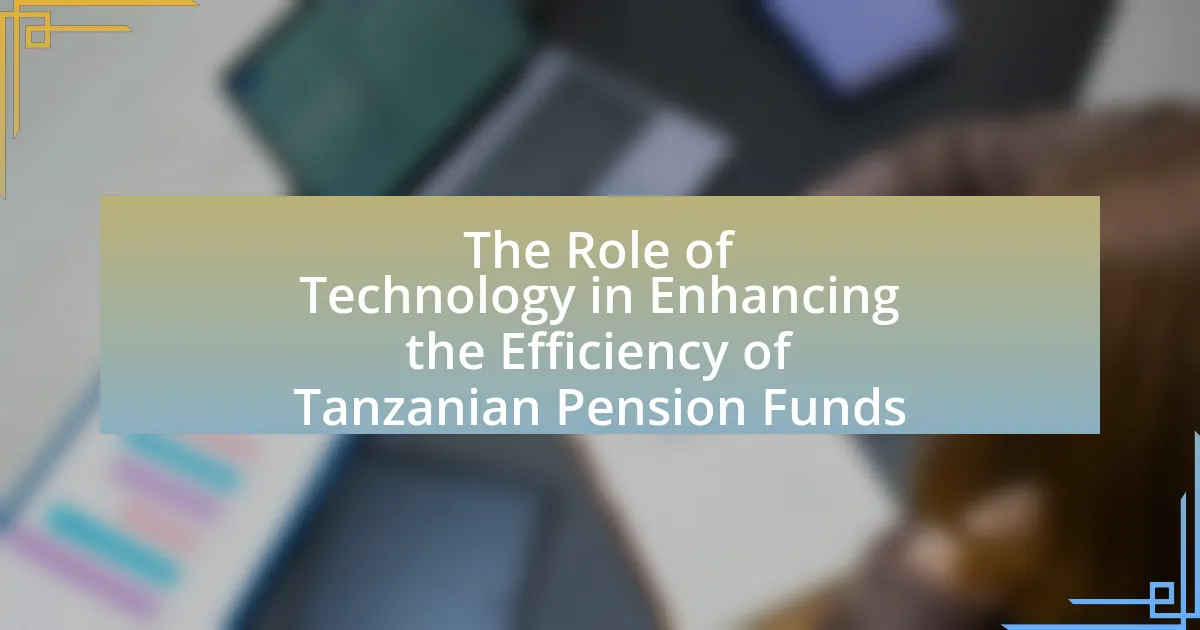The article analyzes the investment strategies of Tanzanian pension funds, highlighting their diversified approach that includes equities, government bonds, real estate, and cash instruments. It discusses how regulatory frameworks, economic conditions, and demographic changes influence these strategies, as well as the challenges faced, such as limited investment options and market volatility. The article also examines the metrics used to measure investment performance, the impact of technology and global trends on local strategies, and the importance of sustainable investment practices. Overall, it provides a comprehensive overview of how Tanzanian pension funds manage their assets to ensure long-term growth and stability for their beneficiaries.
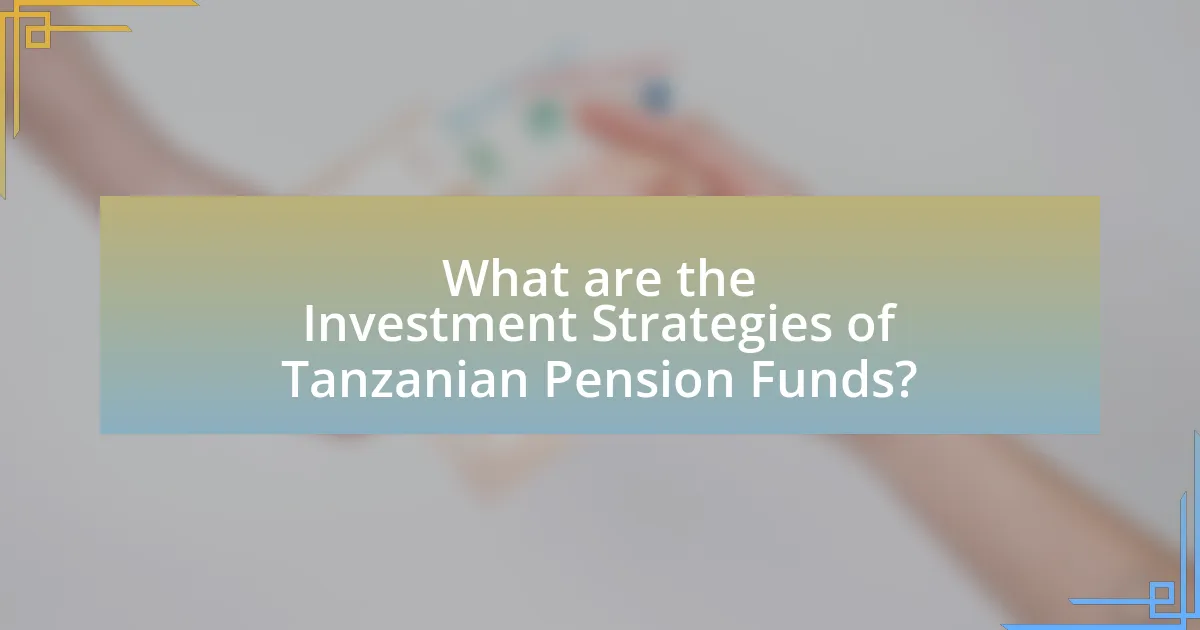
What are the Investment Strategies of Tanzanian Pension Funds?
Tanzanian pension funds primarily employ a diversified investment strategy that includes equities, government bonds, real estate, and cash instruments. This diversification aims to balance risk and return, ensuring stable growth for pension assets. For instance, as of 2021, approximately 40% of pension fund assets were allocated to government securities, reflecting a preference for low-risk investments, while around 20% were invested in equities, indicating a pursuit of higher returns. Additionally, real estate investments have gained traction, with funds increasingly recognizing the potential for capital appreciation and rental income. This strategic allocation is guided by regulatory frameworks that mandate specific investment limits, ensuring that pension funds maintain a balanced portfolio to safeguard members’ retirement savings.
How do Tanzanian pension funds determine their investment strategies?
Tanzanian pension funds determine their investment strategies primarily through regulatory frameworks, risk assessments, and asset allocation models. The regulatory framework, established by the Pension Funds Act, mandates that pension funds diversify their investments to mitigate risks and ensure long-term sustainability. Risk assessments involve evaluating market conditions, economic indicators, and the financial health of potential investment opportunities. Additionally, asset allocation models guide pension funds in distributing their investments across various asset classes, such as equities, bonds, and real estate, to optimize returns while managing risk. These strategies are further influenced by the funds’ specific objectives, member demographics, and the need to meet future liabilities.
What factors influence the investment decisions of Tanzanian pension funds?
The investment decisions of Tanzanian pension funds are influenced by regulatory frameworks, economic conditions, and risk management strategies. Regulatory frameworks, such as the Pension Act of 2008, dictate the allowable investment avenues and risk profiles for pension funds, ensuring compliance and safeguarding beneficiaries’ interests. Economic conditions, including inflation rates and GDP growth, affect the expected returns on various asset classes, guiding pension funds in their allocation strategies. Additionally, risk management strategies, which involve assessing market volatility and diversification, play a crucial role in determining how pension funds balance their portfolios to achieve optimal returns while minimizing risks.
How do regulatory frameworks impact investment strategies?
Regulatory frameworks significantly shape investment strategies by establishing the rules and guidelines that govern financial markets and institutions. In the context of Tanzanian pension funds, these frameworks dictate asset allocation limits, investment types, and risk management practices, thereby influencing how pension funds construct their portfolios. For instance, the Pension Act of 2008 in Tanzania mandates that pension funds invest a minimum of 30% of their assets in government securities, which directly affects the liquidity and risk profile of their investments. Additionally, compliance with regulations ensures that pension funds operate within legal boundaries, promoting stability and protecting beneficiaries’ interests. This regulatory environment ultimately guides investment decisions, risk assessments, and strategic planning for pension funds in Tanzania.
What types of assets do Tanzanian pension funds typically invest in?
Tanzanian pension funds typically invest in a diverse range of assets, including government bonds, equities, real estate, and cash instruments. Government bonds are favored for their stability and security, while equities provide growth potential. Real estate investments offer diversification and potential rental income. Cash instruments are included for liquidity purposes. According to the National Social Security Fund (NSSF) of Tanzania, as of 2022, approximately 40% of pension fund assets were allocated to government securities, 30% to equities, and the remainder to real estate and cash, reflecting a balanced investment strategy aimed at risk management and returns.
What are the most common asset classes for these funds?
The most common asset classes for Tanzanian pension funds include equities, fixed income securities, real estate, and cash equivalents. Equities represent a significant portion of the investment portfolio, often providing growth potential, while fixed income securities offer stability and income generation. Real estate investments are utilized for diversification and potential appreciation, and cash equivalents ensure liquidity for operational needs. These asset classes are strategically selected to balance risk and return, aligning with the funds’ long-term objectives.
How do pension funds balance risk and return in their asset allocation?
Pension funds balance risk and return in their asset allocation by diversifying investments across various asset classes, such as equities, bonds, and real estate, to optimize the risk-return profile. This strategy allows pension funds to mitigate potential losses from any single investment while aiming for a stable return over the long term. For instance, a typical allocation might include a higher percentage in equities for growth potential, balanced by fixed-income securities to provide stability and income. Research indicates that a well-diversified portfolio can reduce volatility and enhance returns, as evidenced by historical data showing that diversified portfolios tend to outperform concentrated ones over time.
What challenges do Tanzanian pension funds face in their investment strategies?
Tanzanian pension funds face several challenges in their investment strategies, primarily including limited investment options, regulatory constraints, and market volatility. Limited investment options arise from a lack of diversified assets available in the local market, which restricts pension funds from achieving optimal returns. Regulatory constraints, such as investment guidelines that mandate a significant portion of assets to be held in government securities, further limit the flexibility of pension funds to explore higher-yielding opportunities. Additionally, market volatility, influenced by economic factors and political instability, poses risks that can adversely affect the performance of pension fund investments. These challenges hinder the ability of Tanzanian pension funds to effectively grow their assets and meet the long-term financial needs of their beneficiaries.
How do market volatility and economic conditions affect their strategies?
Market volatility and economic conditions significantly influence the investment strategies of Tanzanian pension funds by dictating asset allocation and risk management approaches. During periods of high market volatility, pension funds may adopt a more conservative strategy, reallocating assets towards safer investments such as government bonds or cash equivalents to mitigate risk. Conversely, in stable economic conditions, these funds might pursue more aggressive strategies, investing in equities or alternative assets to maximize returns. Historical data shows that in 2020, amidst the COVID-19 pandemic, many pension funds in Tanzania shifted their portfolios to reduce exposure to volatile sectors, reflecting a strategic response to economic uncertainty. This adaptability in strategy underscores the importance of aligning investment decisions with prevailing market conditions to safeguard beneficiaries’ interests.
What are the implications of demographic changes on investment strategies?
Demographic changes significantly impact investment strategies by altering the risk tolerance and asset allocation preferences of investors. As populations age, there is a shift towards more conservative investment approaches, favoring fixed-income securities over equities to ensure capital preservation and income generation. For instance, the World Bank reports that in countries with aging populations, pension funds tend to increase their allocations to bonds, which are perceived as safer investments, while reducing exposure to volatile stocks. Additionally, younger demographics may drive demand for growth-oriented investments, influencing pension funds to diversify their portfolios to include technology and sustainable investments. This duality in demographic trends necessitates a dynamic investment strategy that balances the needs of both older and younger investors, ensuring long-term sustainability and growth of pension funds.
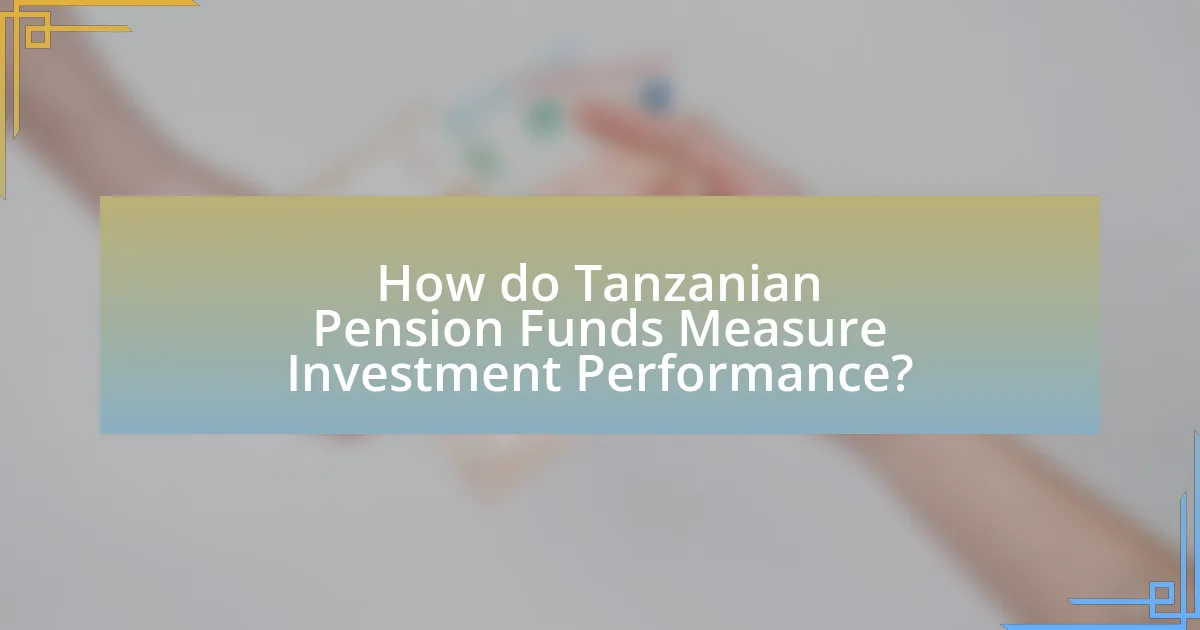
How do Tanzanian Pension Funds Measure Investment Performance?
Tanzanian pension funds measure investment performance primarily through benchmarks, risk-adjusted returns, and compliance with regulatory requirements. These funds often compare their investment returns against established market indices to assess performance relative to the broader market. For instance, the National Social Security Fund (NSSF) in Tanzania utilizes the Tanzania Stock Exchange Index as a benchmark to evaluate its equity investments. Additionally, pension funds analyze risk-adjusted metrics such as the Sharpe ratio, which helps in understanding the return generated per unit of risk taken. Compliance with the Pension Funds Act also mandates that funds report their performance transparently, ensuring accountability and adherence to investment guidelines.
What metrics are used to evaluate the performance of pension fund investments?
The primary metrics used to evaluate the performance of pension fund investments include the rate of return, risk-adjusted return, and the Sharpe ratio. The rate of return measures the percentage increase in the value of the fund over a specific period, providing a direct indication of investment performance. Risk-adjusted return accounts for the volatility of the investments, allowing for a comparison of returns relative to the risk taken. The Sharpe ratio, which is calculated by subtracting the risk-free rate from the fund’s return and dividing by the standard deviation of the fund’s returns, quantifies the return per unit of risk, making it a crucial metric for assessing efficiency in investment strategies. These metrics are essential for pension funds to ensure they meet their long-term obligations to beneficiaries while managing risks effectively.
How do these metrics compare to industry benchmarks?
The metrics of Tanzanian pension funds generally fall below industry benchmarks, indicating a need for improvement in investment performance. For instance, while the average return on investment for pension funds globally is around 6-8%, Tanzanian pension funds have reported returns closer to 4-5%. This discrepancy highlights the challenges faced by these funds in achieving competitive performance, often attributed to limited investment options and regulatory constraints.
What role does risk-adjusted return play in performance evaluation?
Risk-adjusted return is crucial in performance evaluation as it measures the return of an investment relative to its risk, allowing for a more accurate assessment of investment performance. By incorporating risk into the evaluation, investors can compare different investment options on a level playing field, ensuring that higher returns are not solely a result of taking on excessive risk. For instance, metrics such as the Sharpe Ratio quantify risk-adjusted returns by comparing the excess return of an investment to its standard deviation, providing a clear picture of how well an investment compensates for its risk. This approach is particularly relevant for Tanzanian pension funds, as it helps in making informed decisions that align with their risk tolerance and investment objectives.
How frequently do pension funds assess their investment performance?
Pension funds typically assess their investment performance on a quarterly basis. This frequency allows them to evaluate their portfolio’s returns against benchmarks and make necessary adjustments to their investment strategies. According to the International Organization of Pension Supervisors, regular performance assessments are crucial for ensuring that pension funds meet their long-term obligations to beneficiaries.
What processes are in place for ongoing performance monitoring?
Ongoing performance monitoring for Tanzanian pension funds involves systematic evaluation processes that include regular performance reviews, benchmarking against industry standards, and compliance assessments. These processes ensure that investment strategies align with the funds’ objectives and regulatory requirements. For instance, pension funds typically conduct quarterly performance reports that analyze returns relative to benchmarks, allowing for timely adjustments to investment strategies. Additionally, adherence to the guidelines set by the Pension Funds Act of 2004 mandates that funds maintain transparency and accountability in their investment practices, further reinforcing the effectiveness of ongoing performance monitoring.
How do funds adjust strategies based on performance assessments?
Funds adjust strategies based on performance assessments by analyzing investment returns against benchmarks and reallocating assets to optimize performance. For instance, if a fund consistently underperforms its benchmark, it may shift its asset allocation towards higher-performing sectors or asset classes. This approach is supported by data indicating that funds that actively adjust their strategies in response to performance metrics tend to achieve better long-term returns. Research shows that pension funds that utilize performance assessments to guide strategic adjustments can enhance their overall portfolio efficiency and risk management.
What are the best practices for reporting investment performance?
The best practices for reporting investment performance include using standardized performance metrics, ensuring transparency in reporting, and providing context for performance results. Standardized metrics, such as the Time-Weighted Rate of Return (TWRR) and the Internal Rate of Return (IRR), allow for consistent comparisons across different investment periods and strategies. Transparency involves disclosing fees, risks, and the methodologies used in performance calculations, which builds trust with stakeholders. Providing context, such as benchmarks and market conditions, helps stakeholders understand the performance relative to expectations and market movements. These practices are essential for accurate and reliable investment performance reporting, as they enhance clarity and facilitate informed decision-making.
How can transparency in reporting enhance stakeholder trust?
Transparency in reporting enhances stakeholder trust by providing clear, accurate, and timely information about financial performance and decision-making processes. When stakeholders, such as investors and beneficiaries, have access to transparent reports, they can better assess the integrity and reliability of the pension fund’s management. For instance, a study by the CFA Institute found that organizations with high transparency levels experience a 20% increase in stakeholder trust, as stakeholders feel more informed and engaged in the fund’s operations. This trust is crucial for fostering long-term relationships and encouraging investment, ultimately leading to better financial outcomes for the pension fund.
What challenges exist in communicating performance to stakeholders?
Challenges in communicating performance to stakeholders include the complexity of financial data, differing stakeholder expectations, and the potential for misinterpretation. Financial data often involves intricate metrics that can confuse stakeholders who lack expertise, leading to misunderstandings about performance. Additionally, stakeholders may have varying priorities and expectations, making it difficult to present a unified narrative that satisfies all parties. Misinterpretation can arise from the use of jargon or technical language, which may alienate non-expert stakeholders and obscure the true performance picture. These challenges necessitate clear, tailored communication strategies to ensure that performance is accurately conveyed and understood.

What Future Trends are Influencing Tanzanian Pension Fund Investment Strategies?
Future trends influencing Tanzanian pension fund investment strategies include increased focus on sustainable investments, technological advancements, and demographic shifts. Sustainable investments are gaining traction as pension funds seek to align with global environmental, social, and governance (ESG) standards, reflecting a broader commitment to responsible investing. Technological advancements, particularly in fintech, are enabling more efficient asset management and data analysis, allowing pension funds to optimize their portfolios. Additionally, demographic shifts, such as an aging population and urbanization, are prompting pension funds to adapt their strategies to meet the changing needs of beneficiaries, ensuring long-term financial stability. These trends are reshaping how Tanzanian pension funds allocate resources and manage risks in a dynamic economic landscape.
How is technology shaping the investment strategies of pension funds?
Technology is significantly shaping the investment strategies of pension funds by enhancing data analytics, improving risk management, and facilitating access to diverse investment opportunities. Advanced data analytics tools enable pension funds to analyze vast amounts of market data, leading to more informed investment decisions. For instance, machine learning algorithms can identify trends and predict market movements, allowing funds to optimize their portfolios. Additionally, technology improves risk management through real-time monitoring and predictive modeling, which helps pension funds mitigate potential losses. Furthermore, digital platforms provide pension funds with access to alternative investments, such as private equity and real estate, which were previously less accessible. This shift towards technology-driven strategies is evident in the increasing adoption of fintech solutions within the pension fund sector, reflecting a broader trend towards modernization and efficiency in investment practices.
What role do fintech innovations play in investment decision-making?
Fintech innovations significantly enhance investment decision-making by providing advanced data analytics, real-time market insights, and automated trading solutions. These technologies enable investors to analyze vast amounts of data quickly, leading to more informed decisions. For instance, platforms utilizing machine learning algorithms can identify trends and patterns in financial markets that human analysts might overlook, thereby increasing the accuracy of investment predictions. Additionally, fintech tools facilitate access to diverse investment opportunities, allowing pension funds to optimize their portfolios and manage risks more effectively. The integration of fintech in investment strategies has been shown to improve returns, as evidenced by a report from Deloitte, which highlights that firms leveraging fintech solutions experienced a 20% increase in investment performance compared to those that did not.
How can data analytics improve investment outcomes for pension funds?
Data analytics can significantly improve investment outcomes for pension funds by enabling data-driven decision-making and enhancing risk management. By analyzing historical performance data, market trends, and economic indicators, pension funds can identify optimal asset allocations and investment strategies that align with their long-term goals. For instance, a study by the CFA Institute found that funds utilizing advanced analytics achieved a 20% higher return on investment compared to those relying on traditional methods. This demonstrates that leveraging data analytics not only enhances the accuracy of forecasts but also allows pension funds to respond proactively to market changes, ultimately leading to better financial outcomes for beneficiaries.
What impact do global economic trends have on local pension fund strategies?
Global economic trends significantly influence local pension fund strategies by affecting investment returns, risk assessments, and asset allocation decisions. For instance, fluctuations in global interest rates can lead to changes in bond yields, prompting pension funds to adjust their fixed-income investments. Additionally, global market volatility can impact equity investments, leading local pension funds to diversify their portfolios to mitigate risks. According to a 2021 report by the International Monetary Fund, emerging markets, including Tanzania, are increasingly affected by global economic shifts, which necessitates a more adaptive investment approach to ensure long-term sustainability and growth of pension assets.
How do international investment opportunities affect local strategies?
International investment opportunities significantly influence local strategies by encouraging diversification and enhancing risk management for Tanzanian pension funds. These funds often seek to allocate a portion of their assets to international markets to mitigate local economic volatility and achieve higher returns. For instance, a study by the World Bank indicates that pension funds that invest internationally can reduce their portfolio risk by up to 30% compared to those that remain solely domestic. This strategic shift not only helps in stabilizing returns but also fosters the adoption of best practices in governance and investment management, ultimately benefiting the local economy.
What are the implications of climate change on investment decisions?
Climate change significantly influences investment decisions by altering risk assessments and asset valuations. Investors increasingly recognize that climate-related risks, such as extreme weather events and regulatory changes, can impact the financial performance of companies and sectors. For instance, the Task Force on Climate-related Financial Disclosures (TCFD) emphasizes that companies failing to address climate risks may face higher capital costs and reduced investor confidence. Furthermore, a report by the Global Sustainable Investment Alliance indicates that sustainable investment strategies, which consider environmental factors, have grown to represent over 35% of total assets under management globally, reflecting a shift in investor priorities towards climate resilience.
What practical steps can pension funds take to adapt to emerging trends?
Pension funds can adapt to emerging trends by diversifying their investment portfolios to include alternative assets such as renewable energy, technology, and infrastructure. This diversification allows pension funds to mitigate risks associated with traditional investments and capitalize on growth opportunities in rapidly evolving sectors. For instance, a report by the Global Sustainable Investment Alliance indicates that sustainable investments reached $35.3 trillion globally in 2020, highlighting the increasing demand for responsible investment strategies. By incorporating ESG (Environmental, Social, and Governance) criteria into their investment decisions, Tanzanian pension funds can align with global trends and attract more investors. Additionally, leveraging technology for data analytics can enhance decision-making processes, enabling pension funds to respond swiftly to market changes and emerging trends.
How can pension funds enhance their resilience against market changes?
Pension funds can enhance their resilience against market changes by diversifying their investment portfolios across various asset classes, including equities, bonds, real estate, and alternative investments. This diversification reduces the risk associated with market volatility, as different asset classes often respond differently to economic conditions. For instance, during economic downturns, bonds may perform better than equities, providing a buffer against losses. Historical data shows that pension funds with a diversified approach have consistently outperformed those with concentrated investments, particularly during market downturns, thereby validating the effectiveness of this strategy.
What strategies can be implemented to ensure sustainable investment practices?
To ensure sustainable investment practices, pension funds in Tanzania can implement strategies such as integrating Environmental, Social, and Governance (ESG) criteria into their investment decision-making processes. This approach allows funds to assess the long-term sustainability and ethical impact of their investments, which is increasingly important as investors seek to align their portfolios with responsible practices. Research indicates that companies with strong ESG performance tend to exhibit lower risks and better financial returns over time, supporting the case for integrating these criteria into investment strategies. For instance, a study by the Global Sustainable Investment Alliance reported that sustainable investment assets reached $30.7 trillion globally in 2018, reflecting a growing trend among investors prioritizing sustainability.


